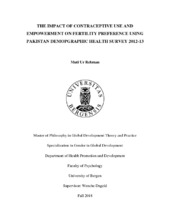| dc.description.abstract | Background: Fertility preference is an area of interest world over, particularly in the past five or six decades, given the prevalence of high fertility rates in many parts of the world. National and international organizations, governments, and policymakers have prioritized the issue by introducing and implementing policies and initiatives to control the rising fertility rates. Different national and international organizations, governments, and policymakers have highlighted the issue and have acted to address the rising fertility rates. In doing so, they have implemented initiatives and introduced policies to control the fertility rate among women. Typically, countries like China and India are renowned for this issue – whereas it is a matter of concern in Pakistan, to a comparatively lower degree. Pakistan is among the world’s many countries that are facing challenges in controlling population growth rates. There is evidence that a significant proportion of women do not want more children in Pakistan. However, a majority of these women do not use contraception to prevent future births. Therefore, it is important to evaluate women’s fertility preferences in a context-specific manner in Pakistan, where the concept of fertility preference differs vividly from that of other countries in South Asia. This study used the empowerment framework (resource, agency, and achievement) proposed by Naila Kabeer (1999). Research Objectives: The objective of this study is to identify key constructs from previous literature and analyze data to understand the relationship between factors that correlate with each other. This study also aims to create a model to identify the factors that work as barriers to the exercise of choice by women in determining their own fertility preferences, such as wanting or not wanting to have more children. Data Material and Methods: This study relied on a quantitative research design and used secondary data from the Pakistan Demographic Health Survey (PDHS) 2012-13. The Statistical Packages for Social Science (SPSS) version 25 was used to run various analyses. The sample in this study comprised 13,479 ever-married women aged between 15 and 49, who answered the questionnaire provided. First, variables were operationalized in the new subsets to make them eligible for final analysis. Therefore, data cleaning, checking for outliers, deletion of duplicate cases, reverse coding of variables, and recoding of variables was done wherever necessary. Background, resource, and agency variables were drawn from the variables in the data. They were analyzed and described using univariate (descriptive) statistics to show their frequency distribution. Bivariate analyses were used to assess the relationship between the variables. Crosstabulation with Chi-Square was used for categorical variables. Independent sample t-test was used for continuous variables. After preliminary analyses, binary logistic regression was conducted. Three basic models were tested before testing the final parsimonious model. Findings: The study found significant differences between women who want more children and those who want no more children. With the increase in age, educational, and wealth, there is a decrease in fertility. Poorer people have more children than richer. The strongest odds for wanting more children were found in Balochistan OR=3.313, followed by Khyber Pakhtunkhwa OR=2.548. Higher odds for wanting no more children was found in the case of the variable “wanted the last child” OR=-2.435. As many as 65% of the respondents had not used any form of contraception. According to the results, decision-making variables do not make any significant contribution to fertility preference. Conclusion: By increasing access to education in the country, fertility preferences will reduce. Cultural norms have a strong influence in society and restrict women from making significant contributions toward decisions specifically related to their health. | en_US |
